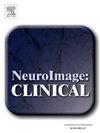CTV-MIND:皮质厚度-体积整合的个体化形态学网络模型探讨颞叶癫痫的疾病进展
IF 3.6
2区 医学
Q2 NEUROIMAGING
引用次数: 0
摘要
颞叶癫痫(TLE)是一种进行性脑网络疾病。阐明网络重组和识别疾病进展相关的生物标志物对于理解病理机制、量化疾病负担和优化临床策略至关重要。本研究旨在通过构建基于t1加权结构磁共振成像(MRI)的新型个体化脑形态网络来研究TLE的进行性变化。收集34例术后无癫痫发作的TLE患者和28例年龄和性别匹配的健康对照(HC)的MRI数据,将患者分为长期组和短期组。通过整合皮质厚度和体积特征(CTV-MIND),利用形态测量反发散(MIND)框架构建个性化形态网络。然后计算并比较各组之间的网络特性,以确定可能与疾病进展相关的特征。结果显示CTV-MIND网络的中枢-节点重组进展,与短期组和HC组相比,长期组在病变侧颞叶的连通性增加。网络节点性质的改变与局部皮质萎缩有显著的相关性。将识别的网络特征整合到基于机器学习的脑年龄预测模型中,进一步揭示了TLE中显著升高的脑年龄。值得注意的是,与持续时间相关的大脑区域比其他区域组合对TLE的过早脑衰老具有更显著和更具体的影响。因此,持续时间延长可能是TLE病理衰老的重要因素。我们的发现可以帮助临床医生更好地识别TLE的异常脑轨迹,并有可能促进个性化治疗策略的优化。本文章由计算机程序翻译,如有差异,请以英文原文为准。
CTV-MIND: A cortical thickness-volume integrated individualized morphological network model to explore disease progression in temporal lobe epilepsy
Temporal lobe epilepsy (TLE) is a progressive brain network disorder. Elucidating network reorganization and identifying disease progression-associated biomarkers are crucial for understanding pathological mechanisms, quantifying disease burden, and optimizing clinical strategies. This study aimed to investigate progressive changes in TLE by constructing a novel individualized morphological brain network based on T1-weighted structural magnetic resonance imaging (MRI). MRI data were collected from 34 postoperative seizure-free TLE patients and 28 age- and sex-matched healthy controls (HC), with patients divided into LONG-TERM and SHORT-TERM groups. Individualized morphological networks were constructed using the Morphometric INverse Divergence (MIND) framework by integrating cortical thickness and volume features (CTV-MIND). Network properties were then calculated and compared across groups to identify features potentially associated with disease progression. Results revealed progressive hub-node reorganization in CTV-MIND networks, with the LONG-TERM group showing increased connectivity in the lesion-side temporal lobe compared to SHORT-TERM and HC groups. The altered network node properties showed a significant correlation with local cortical atrophy. Incorporating identified network features into a machine learning-based brain age prediction model further revealed significantly elevated brain age in TLE. Notably, duration-related brain regions exerted a more significant and specific impact on premature brain aging in TLE than other regional combinations. Thus, prolonged duration may serve as an important contributor to the pathological aging observed in TLE. Our findings could help clinicians better identify abnormal brain trajectories in TLE and have the potential to facilitate the optimization of personalized treatment strategies.
求助全文
通过发布文献求助,成功后即可免费获取论文全文。
去求助
来源期刊

Neuroimage-Clinical
NEUROIMAGING-
CiteScore
7.50
自引率
4.80%
发文量
368
审稿时长
52 days
期刊介绍:
NeuroImage: Clinical, a journal of diseases, disorders and syndromes involving the Nervous System, provides a vehicle for communicating important advances in the study of abnormal structure-function relationships of the human nervous system based on imaging.
The focus of NeuroImage: Clinical is on defining changes to the brain associated with primary neurologic and psychiatric diseases and disorders of the nervous system as well as behavioral syndromes and developmental conditions. The main criterion for judging papers is the extent of scientific advancement in the understanding of the pathophysiologic mechanisms of diseases and disorders, in identification of functional models that link clinical signs and symptoms with brain function and in the creation of image based tools applicable to a broad range of clinical needs including diagnosis, monitoring and tracking of illness, predicting therapeutic response and development of new treatments. Papers dealing with structure and function in animal models will also be considered if they reveal mechanisms that can be readily translated to human conditions.
 求助内容:
求助内容: 应助结果提醒方式:
应助结果提醒方式:


